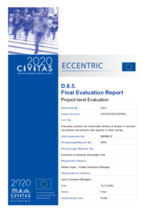
Ruse (Bulgaria)
Druzhba is a new peripheral district in Ruse, home for more than 15% of the population. It is characterised by very intense car traffic, poor PT offer, lack of pedestrian and cycling infrastructure and limited parking spots. The public transport connecting Druzhba to the city center and the industrial zones around the city is slow and unreliable. A large share of the citizens living in Druzhba use personal cars and taxi services for these trips thus causing congestion, traffic accidents, air pollution and noise. Improving the quality of life by applying mobility and infrastructure measures in this district is urgent.
| City area | 127.12 km2 |
| Population | 145 765 |
| Population density | 1 147 inh/km2 |
| Climate | Continental climate with very hot summers and relatively cold winters |
| Gender balance | 49% men / 51% women |
| Average life expectancy | 74.1 years |
| Car ownership rate | 450 cars / 1 000 inhabitants |
| Accident rate | 999 accidents with 8 fatalities and 211 injured (2014) |
Modal Share

Walking
Public transport
Cycling
Cars
Challenges
High traffic and congestion – A large share of citizens living in the peripheral districts use personal cars and taxi services to travel to the city centre or go to work in the industrial zones. High traffic of taxis and personal cars coming from the peripheral district and outside the city towards the city centre lead to congestions and higher risk of road accidents.
Low usage of PT service – The public transport providing the connectivity between the peripheral district "Druzhba", the city centre and the industrial zones around the city is slow and unreliable. There is no opportunity to use public transport after 9 p.m. and citizens prefer to use personal cars and taxi services instead of PT during the late hours of the day. Citizens have limited information and are not able to plan well their time and schedule when using public transport. Most citizens are confused with the routes of the PT lines and don't know how to get from one place to another by using the PT service.
Insecure pedestrian and cycling infrastructure – Lack of pedestrian areas, pavements, crosswalks and high level of accidents. All pedestrian crosswalks in the district are not secure enough and present high risk for accidents leading to injuries and fatalities. Most people with disabilities don't go on the streets or travel around the city due to the lack of convenient infrastructure, specialized public transport vehicles and services; there is a high risk of road accidents involving people with disabilities.
Parking problems – Insufficient parking spaces in the residential area of the peripheral district. Unattractive appearance of the peripheral district because of dirty streets and public spaces packed with cars.
Transport Infrastructure
Car network
67 streets and boulevards with total length of 87 km
Cycling network
14 km of cycling lanes built in 2015 – first stage of the realization of the entire Cycling Master Plan for the City of Ruse.
Public transport network
The total length of the PT network is 63 km. The PT network in the city consists of 26 lines, of which 8 trolleybus and 18 bus lines.
Ruse after ECCENTRIC

- 20% decrease in use of private cars
- 15% growth of active modes in Ruse, enhancing the walkability and cyclability of the demonstration district
- 20% increase in PT usage and 15% increased reliability of PT services in Ruse
- Web portal and a mobile app integrating all PT information in Ruse
- 8 transfer workshops and 8 citizens and NGOs information seminars in Ruse


















